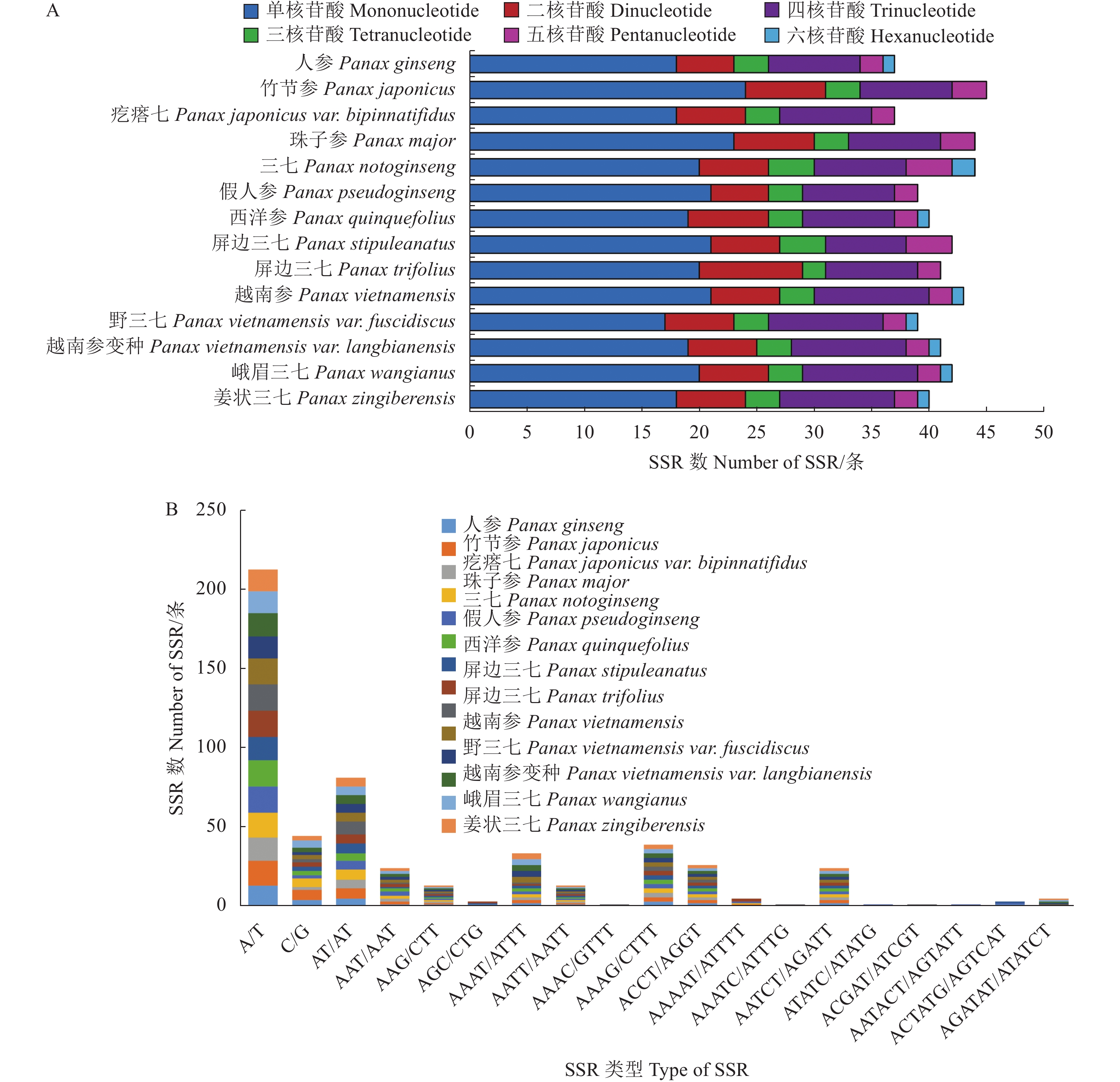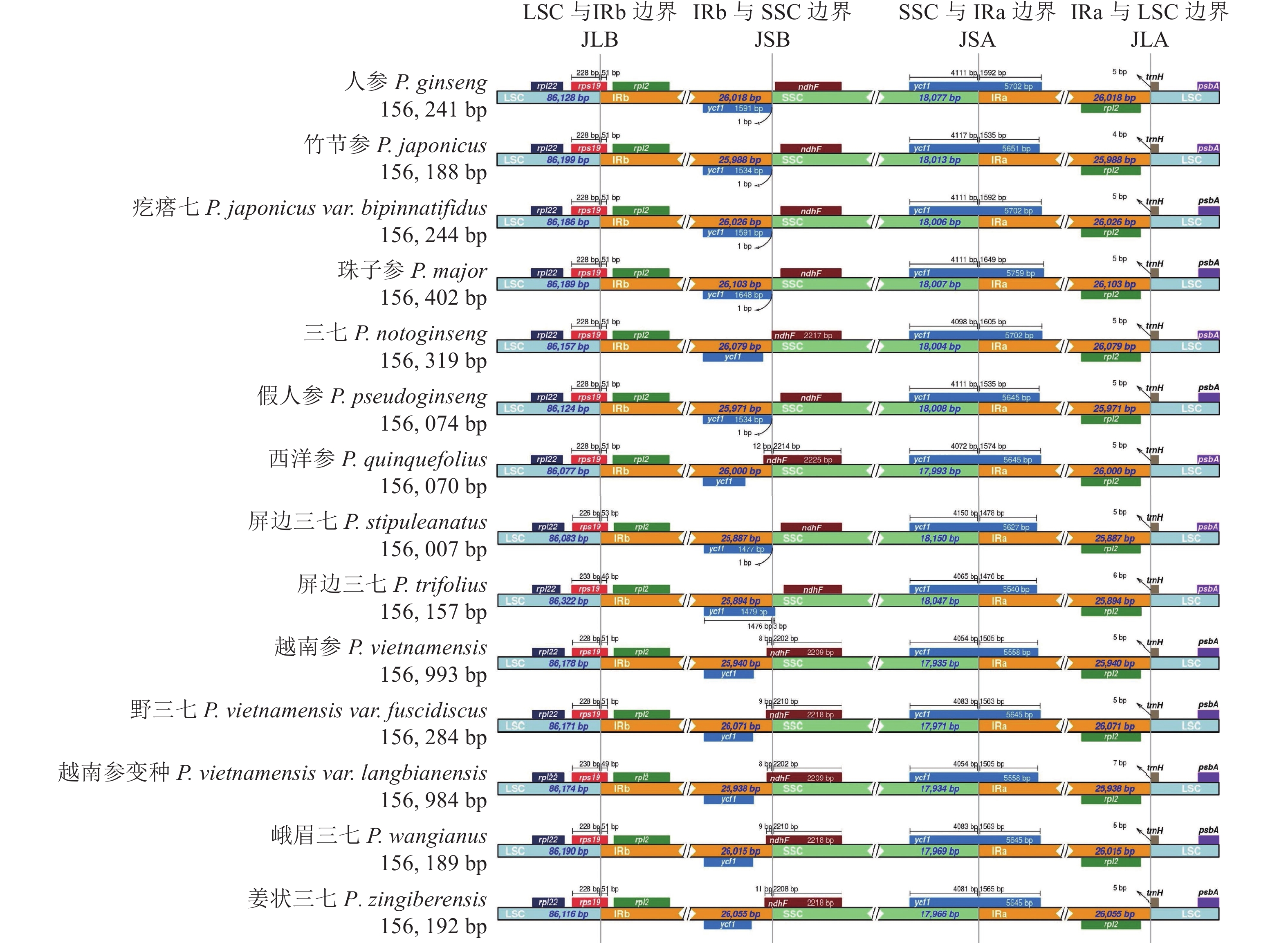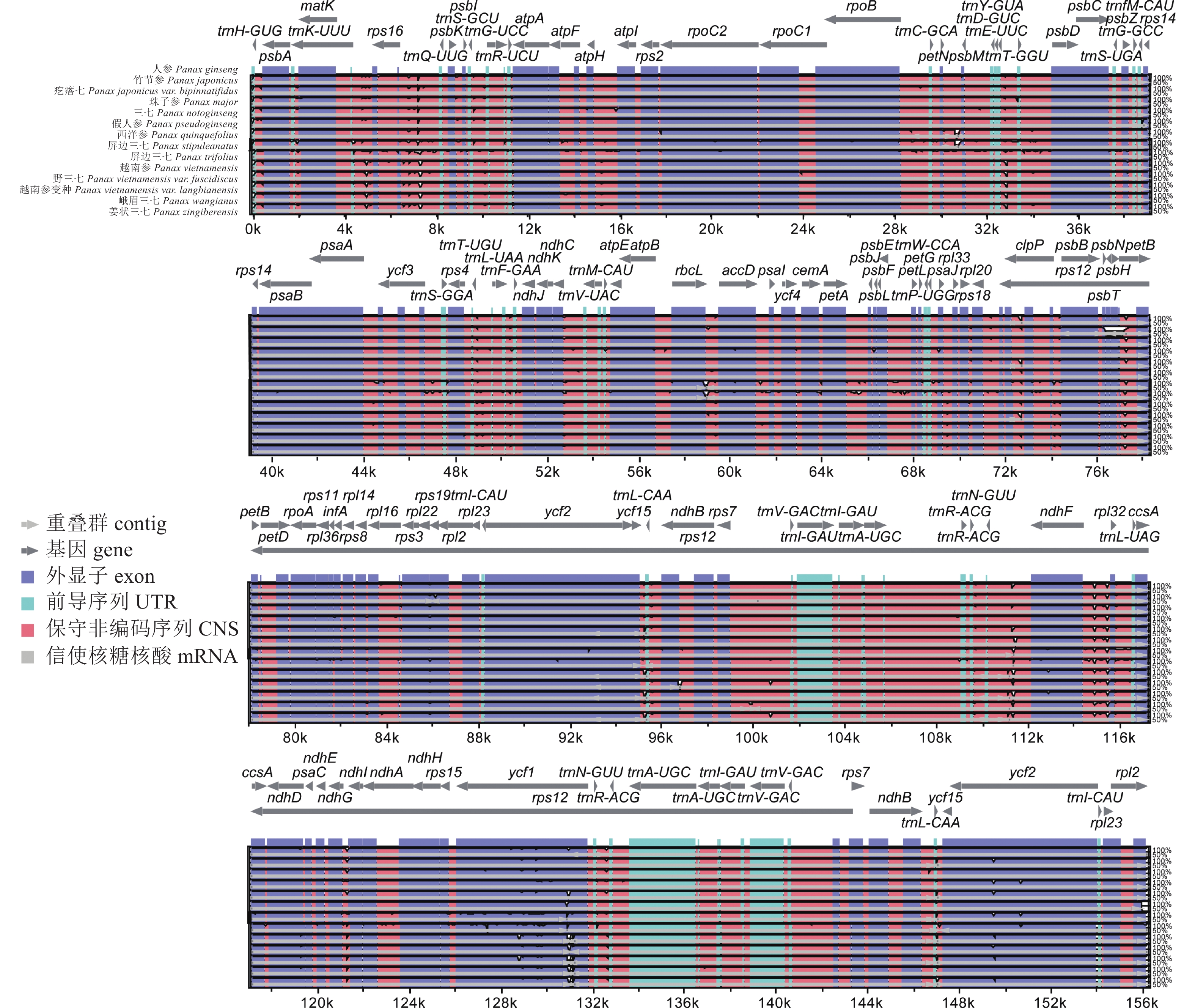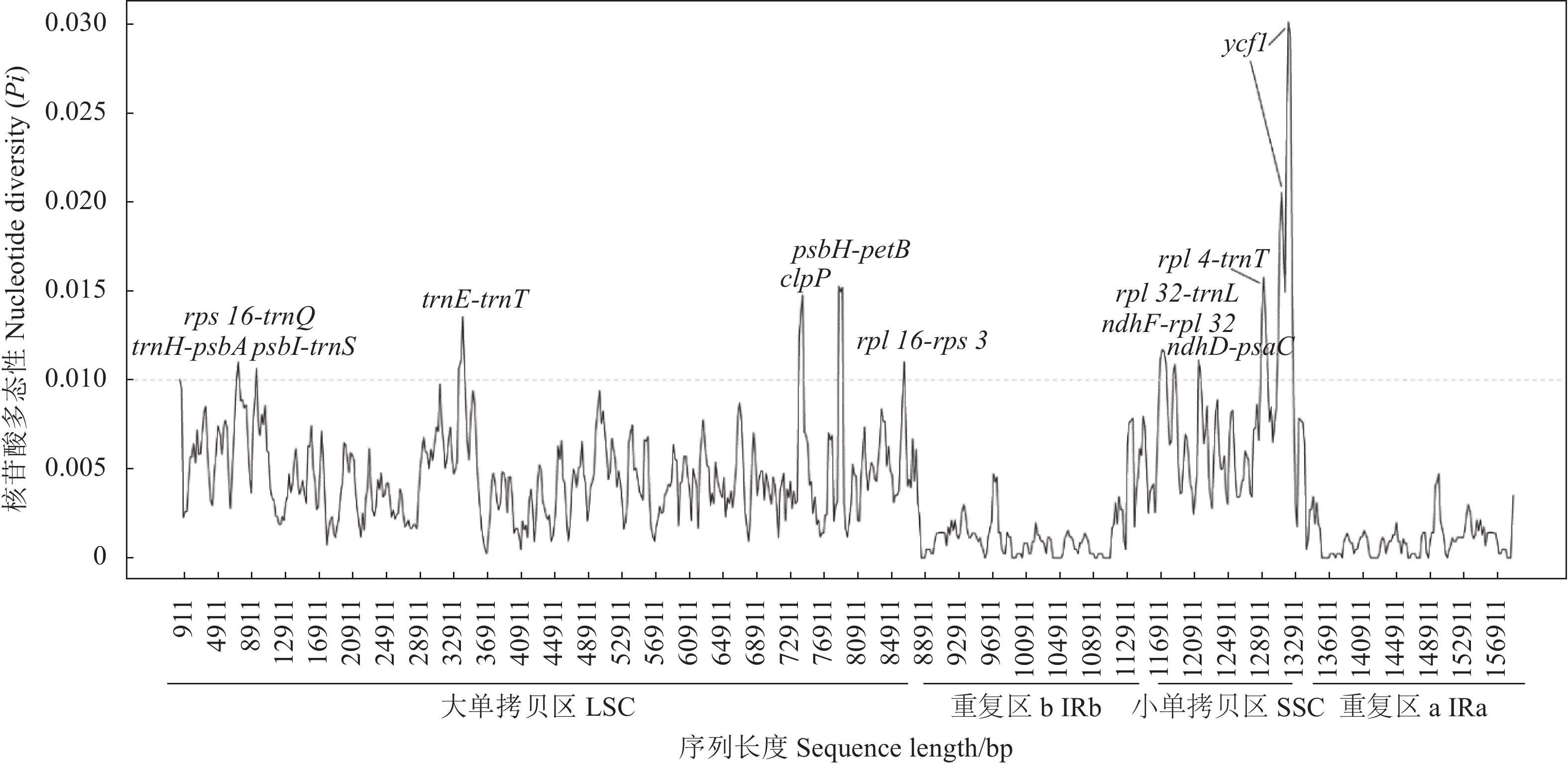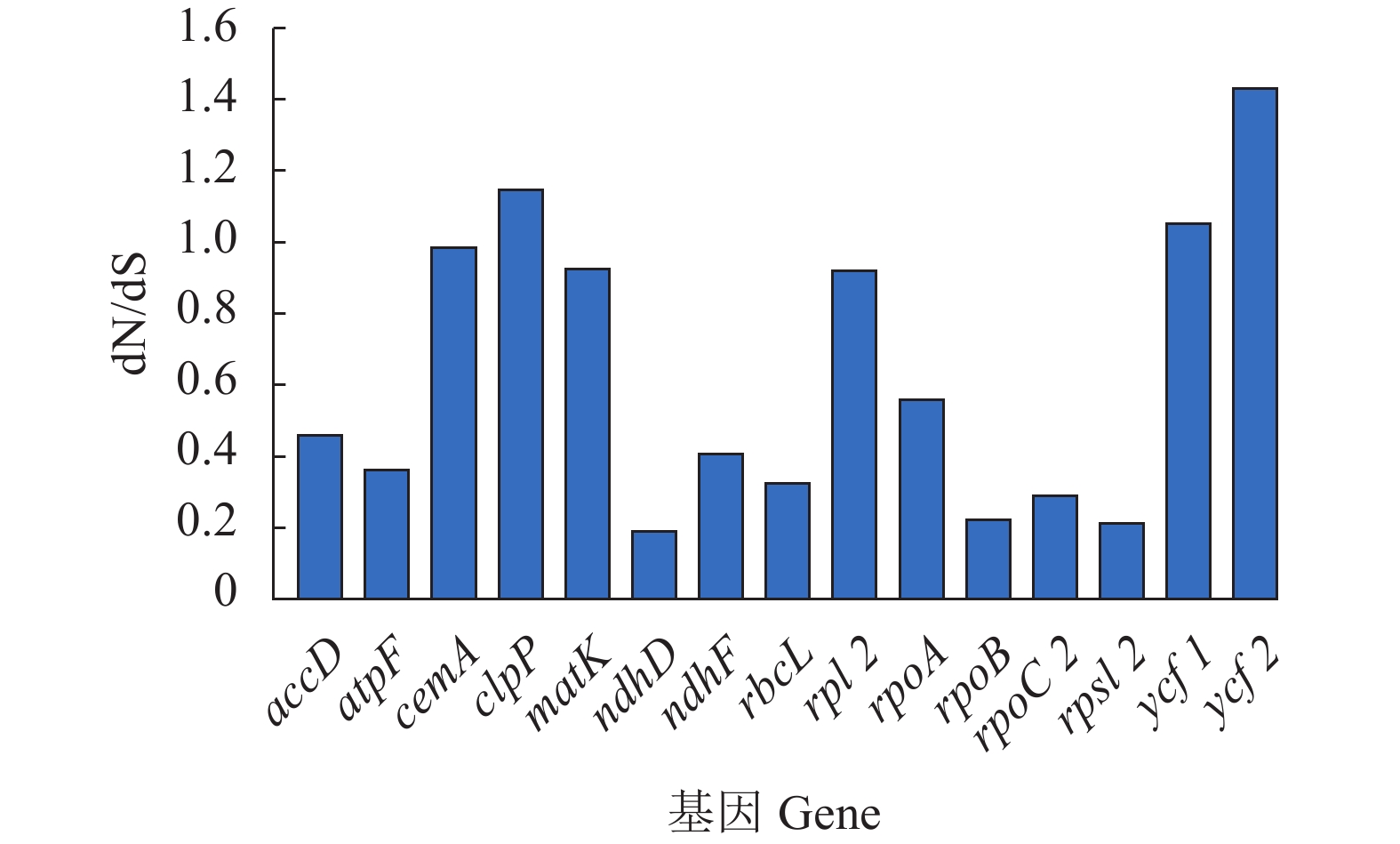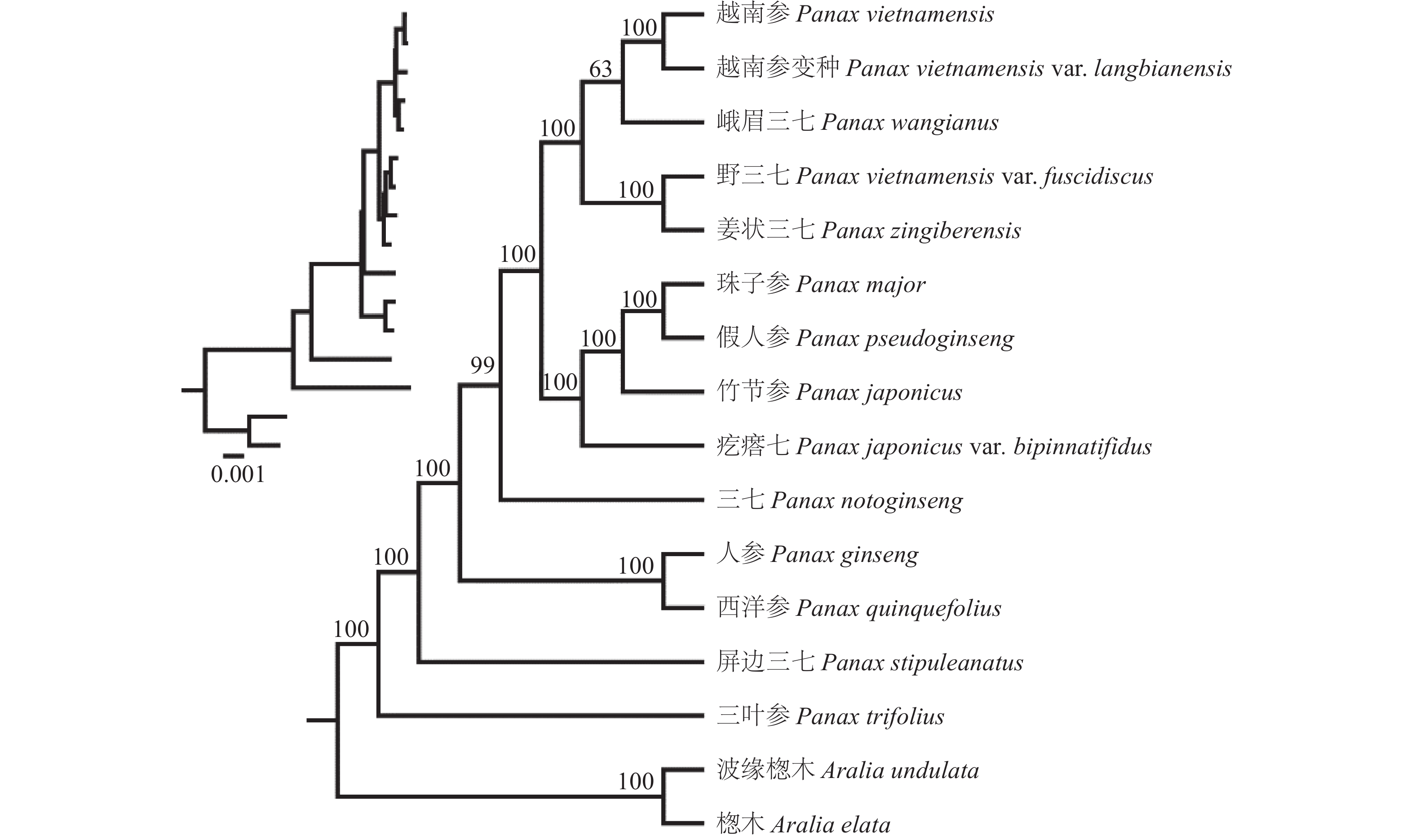Characteristics and Evolution of Panax Chloroplast Genomes
-
摘要:
目的 对人参属(Panax L.)物种叶绿体基因组特征及其系统发育进行研究,为我国人参属资源的遗传学研究和开发利用提供理论依据。 方法 基于14种人参属植物叶绿体基因组序列,利用生物信息学软件,对叶绿体基因组特征、序列重复、结构变异、基因进化和系统发育进行分析。 结果 人参属物种叶绿体基因组均为典型的四分体结构,包含114个unique基因。长重复序列主要为回文重复和正向重复,30~39 bp的重复序列最多,SSR大多为A/T重复,单核苷酸重复是最丰富的类型。人参属叶绿体基因组未发生基因重排,反向重复区(IR)与单拷贝区边界高度保守,鉴定的12个核苷酸高度可变热点中7个位于大单拷贝(LSC)区,5个位于小单拷贝(SSC)区。根据dN/dS比率,发现功能未知基因clpP、ycf1和ycf2受正选择作用。系统发育分析显示,屏边三七和三叶参位于基部支系,四倍体人参和西洋参与其他二倍体物种聚在不同支系,三七、竹节参和越南参则亲缘关系较近。 结论 人参属叶绿体基因组基因数目和顺序一致,基因组结构保守,重复序列数目和类型存在差异,单拷贝区核苷酸多态性高于IR区,正选择基因可能与物种的生态适应性有关。 Abstract:Objective Characteristics and phylogeny of chloroplast genomes of the medicinally and economically valuable species in Panax genus were studied. Methods Using bioinformatics software, the properties, repeats, structural variation, evolution, and phylogeny of the genomes of chloroplasts from 14 ginseng species were analyzed. Results The genomes consisted of typical quadripartite structure with 114 unique genes. The long repeats in them were mainly of palindromic and forward types with a length between 30 bp and 39 bp. The simple sequence repeats were largely A/T type and most abundantly mononucleotides. No gene rearrangement occurred in the genomes was observed. The boundary between the inverted repeat region and the single copy region was highly conserved. Of the 12 regions with highly variable nucleotides, 7 were in the large and 5 in the small single copy region. Indicated by the dN/dS ratios, the positive selection could occur on clpP, ycf1, and ycf2 with unknown functions. The phylogenetic analysis showed that P. stipulenatus and P. trifolius were in the basal lineage, the tetraploid P. ginseng and P. quinquefolius separated from other diploid species, while P. notoginseng, P. japonicus, and P. vietnamensis closely related. Conclusion The chloroplasts of the ginseng species examined were basically same in number and order of genomes, conservative in structure, but divert in number and type of repeats. The nucleotide polymorphism of the chloroplasts was higher in single copy region than inverted repeat regions. The positive selection genes identified in the study might result from the ecological adaptation of these Panax species. -
Key words:
- Panax L. /
- chloroplast genome /
- repeat /
- variation /
- phylogeny
-
表 1 人参属物种叶绿体基因组特征
Table 1. Chloroplast genomes of Panax species
物种 Species 登录号 Accession 长度 Length/bp GC含量 GC content/% 基因组 Genome LSC SSC IR 基因组 Genome LSC SSC IR 人参
P. ginsengMK408938 156 241 86 128 18 077 26 018 38.07 36.27 32.18 43.10 竹节参
P. japonicusKP036469 156 188 86 199 18 013 25 988 38.07 36.29 32.21 43.05 疙瘩七
P. japonicus var. bipinnatifidusMK408962 156 244 86 186 18 006 26 026 38.06 36.28 32.21 43.05 珠子参
P. majorMN496312 156 402 86 189 18 007 26 103 38.07 36.28 32.22 43.05 三七
P. notoginsengMK408945 156 319 86 157 18 004 26 079 38.07 36.27 32.23 43.07 假人参
P. pseudoginsengMW145449 156 074 86 124 18 008 25 971 38.06 36.27 32.22 43.06 西洋参
P. quinquefoliusMK408953 156 070 86 077 17 993 26 000 38.07 36.27 32.22 43.08 屏边三七
P. stipuleanatusMK408965 156 007 86 083 18 150 25 887 38.04 36.26 32.07 43.08 三叶参
P. trifoliusMF100782 156 157 86 322 18 047 25 894 38.08 36.27 32.26 43.10 越南参
P. vietnamensisKP036470 155 993 86 178 17 935 25 940 38.05 36.27 32.22 43.02 野三七
P. vietnamensis var. fuscidiscusMT798585 156 284 86 171 17 971 26 071 38.06 36.28 32.27 42.98 越南参变种
P. vietnamensis var. langbianensisMT798583 155 984 86 174 17 934 25 938 38.05 36.27 32.21 43.03 峨眉三七
P. wangianusMK408964 156 189 86 190 17 969 26 015 38.07 36.29 32.21 43.03 姜状三七
P. zingiberensisMK408969 156 192 86 116 17 966 26 055 38.07 36.31 32.27 43.00 表 2 基于位点模型的人参属叶绿体蛋白编码基因正选择分析
Table 2. Potential positive selection test on chloroplast genomes of Panax species based on site model
基因
GeneM1 vs M2 M7 vs M8 正选择位点
Positively selected sites2ΔlnL P 值 2ΔlnL P 值 accD 2.39 3.0×10-1 2.47 2.9×10-1 139 Q, 0.505; 141 S, 0.517; 144 R, 0.528; 209 A, 0.856; 264 E, 0.504; 364 I, 0.507; 372 L, 0.526; 494 Q, 0.855 atpF 3.37 1.9×10-1 3.42 1.8×10-1 14 W, 0.541; 77 Q, 0.537; 158 G, 0.854 cemA 7.48 2.4×10-2 7.48 2.4×10-2 14 A, 0.547; 22 W, 0.538; 54 K, 0.536; 102 D, 0.533; 103 R, 0.544; 118 V, 0.973*; 205 F, 0.531; 208 W, 0.540 clpP 13.40 1.2×10-3 13.40 1.2×10-3 38 P, 0.990*; 39 V, 0.622; 40 A, 0.935; 41 S, 0.612; 138 G, 0.629; 160 Q, 0.626 matK 19.22 6.7×10-5 19.25 6.6×10-5 83 R, 0.994** ndhD 0.77 6.8×10-1 0.99 6.1×10-1 22 F, 0.830; 41 I, 0.829 ndhF 19.81 5.0×10-5 20.29 3.9×10-5 17 P, 0.597; 123 R, 0.592; 133 T, 0.583; 223 F, 0.959*; 421 I, 0.964*; 463 Q, 0.591; 483 R, 0.569; 499 H, 0.552; 502 A, 0.965*; 511 Q, 0.591; 512 M, 0.526; 532 K, 0.559; 534 I, 0.962*; 572 N, 0.543; 598 D, 0.573; 606 F, 0.548; 621 L, 0.630; 641 I, 0.549; 642 G, 0.597; 657 G, 0.594; 670 A, 0.963*; 677 I, 0.532; 703 S, 0.548; 737 Y, 0.964*; 743 F, 0.537; 745 D, 0.958*; 746 L, 1.000** rbcL 15.94 3.5×10-4 16.10 3.2×10-4 225 L, 0.632; 226 Y, 0.969*; 230 A, 0.635; 270 I, 0.866; 281 A, 0.644; 328 S, 0.999**; 353 F, 0.584; 439 R, 0.968*; 472 V, 0.609; 474 I, 0.621; 478 V, 0.714 rpl2 0 1 0 1 99 K, 0.651; 265 D, 0.650; 267 L, 0.652 rpoA 14.53 7.0×10-4 14.56 6.9×10-4 34 L, 0.506; 256 E, 0.991**; 264 N, 0.999**; 272 S, 0.533; 320 A, 0.849; 337 L, 0.537 rpoB 0.90 6.4×10-1 0.90 6.4×10-1 37 Y, 0.505; 165 R, 0.502; 193 R, 0.502; 295 I, 0.502; 365 T, 0.504; 459 S, 0.502; 695 K, 0.506; 735 T, 0.504; 935 D, 0.832 rpoC2 0 1 0 1 85 Q, 0.736 rps12 0 1 0.02 9.9×10-1 25 R, 0.502 ycf1 75.81 0 75.78 0 205 K, 1.000**; 206 Y, 0.999**; 288 I, 0.876; 532 T, 0.803; 533 K, 0.956*; 604 R, 0.801; 624 R, 0.825; 668 I, 0.779; 685 W, 0.837; 699 V, 0.824; 701 Q, 0.802; 706 V, 0.814; 720 V, 0.856; 722 T, 0.814; 723 D, 0.808; 731 R, 0.982*; 733 K, 0.809; 734 I, 0.996**; 736 L, 0.855; 737 I, 0.803; 751 N, 0.760; 809 A, 0.828; 906 N, 0.768; 914 E, 0.795; 915 L, 0.788; 929 L, 0.835; 957 K, 0.979*; 1030 E, 0.979*; 1116 K, 0.804; 1172 M, 0.731; 1186 Q, 0.798; 1206 Q, 0.798; 1502 Q, 0.754; 1601 I, 1.000**; 1616 D, 0.773;
1631 R, 0.814; 1652 R, 0.795; 1665 V, 0.738; 1685 E, 0.978*; 1710 I, 0.979*; 1739 R, 0.793ycf2 14.95 5.7×10-4 14.95 5.7×10-4 30 R, 0.767; 56 R, 0.770; 103 L, 0.765; 126 S, 0.765; 248 S, 0.769; 285 L, 0.765; 320 L, 0.766; 332 R, 0.764; 432 V, 0.765; 466 Y, 0.765; 573 I, 0.764; 598 L, 0.766; 606 M, 0.759; 759 F, 0.763; 850 S, 0.965*; 943 E, 0.764; 1037 P, 0.766; 1050 F, 0.765; 1064 S, 0.763; 1074 I, 0.965*; 1093 L, 0.767; 1101 N, 0.964*; 1171 W, 0.767; 1173 S, 0.765; 1245 P, 0.766; 1265 D, 0.762; 1309 D, 0.762; 1344 R, 0.764; 1422 L, 0.965*; 1431 F, 0.763; 1522 D, 0.767; 1550 Y, 0.766; 1656 N, 0.763; 1717 S, 0.768; 1799 R, 0.769; 2045 E, 0.764 *和**分别表示正选择位点概率> 95%和> 99%。
* and ** indicate that the probabilities of positively selected sites are > 95% and > 99%, respectively. -
[1] WEN J, ZIMMER E A. Phylogeny and biogeography of Panax L. (The Ginseng Genus, Araliaceae): Inferences from ITS sequences of nuclear ribosomal DNA [J]. Molecular Phylogenetics and Evolution, 1996, 6(2): 167−177. doi: 10.1006/mpev.1996.0069 [2] NGUYEN V B, LINH GIANG V N, WAMINAL N E, et al. Comprehensive comparative analysis of chloroplast genomes from seven Panax species and development of an authentication system based on species-unique single nucleotide polymorphism markers [J]. Journal of Ginseng Research, 2020, 41(1): 135−144. doi: 10.1016/j.jgr.2018.06.003 [3] NGUYEN V B, PARK H S, LEE S C, et al. Authentication markers for five major Panax species developed via comparative analysis of complete chloroplast genome sequences [J]. Journal of Agricultural and Food Chemistry, 2017, 65(30): 6298−6306. doi: 10.1021/acs.jafc.7b00925 [4] LI S, WANG P, YANG W Z, et al. Characterization of the components and pharmacological effects of mountain-cultivated ginseng and garden ginseng based on the integrative pharmacology strategy [J]. Frontiers in Pharmacology, 2021, 12: 659954. doi: 10.3389/fphar.2021.659954 [5] SHIN B K, KWON S W, PARK J H. Chemical diversity of ginseng saponins from Panax ginseng [J]. Journal of Ginseng Research, 2015, 39(4): 287−298. doi: 10.1016/j.jgr.2014.12.005 [6] CHOI H I, KIM N H, LEE J, et al. Evolutionary relationship of Panax ginseng and P. quinquefolius inferred from sequencing and comparative analysis of expressed sequence tags [J]. Genetic Resources and Crop Evolution, 2013, 60(4): 1377−1387. doi: 10.1007/s10722-012-9926-3 [7] YANG Z J, LIU G Z, ZHANG G H, et al. The chromosome-scale high-quality genome assembly of Panax notoginseng provides insight into dencichine biosynthesis [J]. Plant Biotechnology Journal, 2021, 19(5): 869−871. doi: 10.1111/pbi.13558 [8] LIU C, CHEN H H, TANG L Z, et al. Plastid genome evolution of a monophyletic group in the subtribe Lauriineae (Laureae, Lauraceae)[J]. Plant Diversity, 2022 , 44 (4): 377 − 388. DOI: 10.1016/j.pld.2021.11.009 [9] 刘潮, 韩利红, 彭悦, 等. 黄丹木姜子叶绿体基因组特征分析 [J]. 南方农业学报, 2022, 53(1):12−20. doi: 10.3969/j.issn.2095-1191.2022.01.002LIU C, HAN L H, PENG Y, et al. Characteristics of chloroplast genome of Litsea elongata(wall. ex nees)Benth. et hook. F [J]. Journal of Southern Agriculture, 2022, 53(1): 12−20.(in Chinese) doi: 10.3969/j.issn.2095-1191.2022.01.002 [10] 刘潮, 韩利红, 代小波, 等. 辣椒属叶绿体基因组特征及进化 [J]. 热带作物学报, 2022, 43(3):447−454. doi: 10.3969/j.issn.1000-2561.2022.03.002LIU C, HAN L H, DAI X B, et al. Characteristics and phylogenetics of the complete chloroplast genomes of Capsicum species [J]. Chinese Journal of Tropical Crops, 2022, 43(3): 447−454.(in Chinese) doi: 10.3969/j.issn.1000-2561.2022.03.002 [11] YU J J, FU J, FANG Y P, et al. Complete chloroplast genomes of Rubus species (Rosaceae) and comparative analysis within the genus [J]. BMC Genomics, 2022, 23(1): 32. doi: 10.1186/s12864-021-08225-6 [12] 刘潮, 唐利洲, 韩利红. 四川山胡椒叶绿体基因组特征及山胡椒属系统发育 [J]. 林业科学, 2021, 57(12):167−174.LIU C, TANG L Z, HAN L H. Characterization of the chloroplast genome of Lindera setchuenensis and phylogenetics of the genus Lindera [J]. Scientia Silvae Sinicae, 2021, 57(12): 167−174.(in Chinese) [13] LIU C K, YANG Z Y, YANG L F, et al. The complete plastome of Panax stipuleanatus: Comparative and phylogenetic analyses of the genus Panax (Araliaceae) [J]. Plant Diversity, 2018, 40(6): 265−276. doi: 10.1016/j.pld.2018.11.001 [14] 岳杰. 四种人参属植物叶绿体全基因组结构及其系统发育分析[D]. 汉中: 陕西理工大学, 2021YUE J. Structural and phylogenetic analyses of the complete chloroplast genomes of four species within the genus Panax linn. [D]. Hanzhong: Shaanxi University of Technology, 2021. (in Chinese) [15] KURTZ S, CHOUDHURI J V, OHLEBUSCH E, et al. REPuter: The manifold applications of repeat analysis on a genomic scale [J]. Nucleic Acids Research, 2001, 29(22): 4633−4642. doi: 10.1093/nar/29.22.4633 [16] BEIER S, THIEL T, MÜNCH T, et al. MISA-web: A web server for microsatellite prediction [J]. Bioinformatics, 2017, 33(16): 2583−2585. doi: 10.1093/bioinformatics/btx198 [17] AMIRYOUSEFI A, HYVÖNEN J, POCZAI P. IRscope: An online program to visualize the junction sites of chloroplast genomes [J]. Bioinformatics (Oxford, England), 2018, 34(17): 3030−3031. doi: 10.1093/bioinformatics/bty220 [18] FRAZER K A, PACHTER L, POLIAKOV A, et al. VISTA: Computational tools for comparative genomics[J]. Nucleic Acids Research, 2004, 32(Web Server issue): W273-W279. [19] KATOH K, ROZEWICKI J, YAMADA K D. MAFFT online service: Multiple sequence alignment, interactive sequence choice and visualization [J]. Briefings in Bioinformatics, 2019, 20(4): 1160−1166. doi: 10.1093/bib/bbx108 [20] ROZAS J, FERRER-MATA A, SÁNCHEZ-DELBARRIO J C, et al. DnaSP 6: DNA sequence polymorphism analysis of large data sets [J]. Molecular Biology and Evolution, 2017, 34(12): 3299−3302. doi: 10.1093/molbev/msx248 [21] XU B, YANG Z H. PAMLX: A graphical user interface for PAML [J]. Molecular Biology and Evolution, 2013, 30(12): 2723−2724. doi: 10.1093/molbev/mst179 [22] MINH B Q, SCHMIDT H A, CHERNOMOR O, et al. IQ-TREE 2: New models and efficient methods for phylogenetic inference in the genomic era [J]. Molecular Biology and Evolution, 2020, 37(5): 1530−1534. doi: 10.1093/molbev/msaa015 [23] GANLEY A R D, KOBAYASHI T. Monitoring the rate and dynamics of concerted evolution in the ribosomal DNA repeats of Saccharomyces cerevisiae using experimental evolution [J]. Molecular Biology and Evolution, 2011, 28(10): 2883−2891. doi: 10.1093/molbev/msr117 [24] ZEB U, DONG W L, ZHANG T T, et al. Comparative plastid genomics of Pinus species: Insights into sequence variations and phylogenetic relationships [J]. Journal of Systematics and Evolution, 2020, 58(2): 118−132. doi: 10.1111/jse.12492 [25] ZHU B, QIAN F, HOU Y F, et al. Complete chloroplast genome features and phylogenetic analysis of Eruca sativa (Brassicaceae) [J]. PLoS One, 2021, 16(3): e0248556. doi: 10.1371/journal.pone.0248556 [26] LI D M, YE Y J, XU Y C, et al. Complete chloroplast genomes of Zingiber montanum and Zingiber zerumbet: Genome structure, comparative and phylogenetic analyses [J]. PLoS One, 2020, 15(7): e0236590. doi: 10.1371/journal.pone.0236590 [27] XU K W, LIN C X, LEE S Y, et al. Comparative analysis of complete Ilex (Aquifoliaceae) chloroplast genomes: Insights into evolutionary dynamics and phylogenetic relationships [J]. BMC Genomics, 2022, 23(1): 203. doi: 10.1186/s12864-022-08397-9 [28] KASHI Y, KING D G. Simple sequence repeats as advantageous mutators in evolution [J]. Trends in Genetics, 2006, 22(5): 253−259. doi: 10.1016/j.tig.2006.03.005 [29] HAN C Y, DING R, ZONG X Y, et al. Structural characterization of Platanthera ussuriensis chloroplast genome and comparative analyses with other species of Orchidaceae [J]. BMC Genomics, 2022, 23(1): 84. doi: 10.1186/s12864-022-08319-9 [30] YAN J W, LI J H, YU L, et al. Comparative chloroplast genomes of Prunus subgenus Cerasus (Rosaceae): Insights into sequence variations and phylogenetic relationships [J]. Tree Genetics & Genomes, 2021, 17(6): 50. [31] 马孟莉, 张薇, 孟衡玲, 等. 草果叶绿体基因组特征及系统发育分析 [J]. 中草药, 2021, 52(19):6023−6031. doi: 10.7501/j.issn.0253-2670.2021.19.025MA M L, ZHANG W, MENG H L, et al. Characterization and phylogenetic analysis of the complete chloroplast genome of Amomum tsao-ko [J]. Chinese Traditional and Herbal Drugs, 2021, 52(19): 6023−6031.(in Chinese) doi: 10.7501/j.issn.0253-2670.2021.19.025 [32] KIM K J. Complete chloroplast genome sequences from Korean ginseng (Panax schinseng nees) and comparative analysis of sequence evolution among 17 vascular plants [J]. DNA Research, 2004, 11(4): 247−261. doi: 10.1093/dnares/11.4.247 [33] LI R, MA P F, WEN J, et al. Complete sequencing of five Araliaceae chloroplast genomes and the phylogenetic implications [J]. PLoS One, 2013, 8(10): e78568. doi: 10.1371/journal.pone.0078568 [34] TROFIMOV D, CADAR D, SCHMIDT-CHANASIT J, et al. A comparative analysis of complete chloroplast genomes of seven Ocotea species (Lauraceae) confirms low sequence divergence within the Ocotea complex [J]. Scientific Reports, 2022, 12: 1120. doi: 10.1038/s41598-021-04635-4 [35] YANG J, CHIANG Y C, HSU T W, et al. Characterization and comparative analysis among plastome sequences of eight endemic Rubus (Rosaceae) species in Taiwan [J]. Scientific Reports, 2021, 11: 1152. doi: 10.1038/s41598-020-80143-1 [36] NIU Y F, GAO C W, LIU J. Comparative analysis of the complete plastid genomes of Mangifera species and gene transfer between plastid and mitochondrial genomes [J]. PeerJ, 2021, 9: e10774. doi: 10.7717/peerj.10774 [37] GARUD N R, POLLARD K S. Population genetics in the human microbiome [J]. Trends in Genetics:TIG, 2020, 36(1): 53−67. doi: 10.1016/j.tig.2019.10.010 [38] JI Y H, LIU C K, YANG Z Y, et al. Testing and using complete plastomes and ribosomal DNA sequences as the next generation DNA barcodes in Panax (Araliaceae) [J]. Molecular Ecology Resources, 2019, 19(5): 1333−1345. doi: 10.1111/1755-0998.13050 [39] KIM N H, CHOI H I, KIM K H, et al. Evidence of genome duplication revealed by sequence analysis of multi-loci expressed sequence tag-simple sequence repeat bands in Panax ginseng Meyer [J]. Journal of Ginseng Research, 2014, 38(2): 130−135. doi: 10.1016/j.jgr.2013.12.005 -








 下载:
下载:
